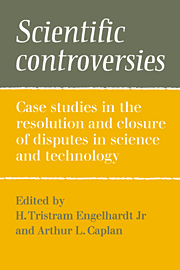 Scientific Controversies
Scientific Controversies Book contents
- Frontmatter
- Contents
- Preface
- List of contributors
- Introduction: Patterns of controversy and closure: the interplay of knowledge, values, and political forces
- PART I THEORETICAL PERSPECTIVES
- PART II CONTEMPORARY CASE STUDIES
- PART III CONTROVERSY, CLOSURE, AND THE PUBLIC
- 26 The role of the mass media in scientific controversy
- 27 The National Commission on Human Experimentation: procedures and outcomes
- 28 The forms and norms of closure
- Author index
- Subject index
28 - The forms and norms of closure
Published online by Cambridge University Press: 03 February 2010
- Frontmatter
- Contents
- Preface
- List of contributors
- Introduction: Patterns of controversy and closure: the interplay of knowledge, values, and political forces
- PART I THEORETICAL PERSPECTIVES
- PART II CONTEMPORARY CASE STUDIES
- PART III CONTROVERSY, CLOSURE, AND THE PUBLIC
- 26 The role of the mass media in scientific controversy
- 27 The National Commission on Human Experimentation: procedures and outcomes
- 28 The forms and norms of closure
- Author index
- Subject index
Summary
The essays in this volume all address in one way or another the subject of closure in science, technology, and public policy. In some of these papers, the primary focus is on a theoretical or conceptual question: What types of closure are there? In other papers, the emphasis is on a historical or sociological question: What forms of closure have been involved in the termination of historical and contemporary controversies involving science and technology? The aim of this concluding chapter is first, to comment on the conceptual and descriptive accounts offered by several of the authors whose essays appear in this volume. A second, related task is to offer a reply to the following normative question: What types of closure should occur or are appropriate for bringing an end to different types of controversies?
Before that normative question can be tackled properly, a systematic review of the papers would have to yield clear answers to this series of prior questions:
What are the different types of controversy for which closure has been sought or in which termination has occurred?
What forms of closure (resolution, termination) can be identified?
Which of those forms of closure have in fact occurred in particular historical and contemporary instances of controversy, as described in the answer to question 1?
What pattern, if any, defines closure reached in debates or disputes in each of the categories of controversy listed in answer to question 1?
Where such patterns can be identified, do they shed any light on what type of closure people have thought to be appropriate to different types of controversy?
[…]
- Type
- Chapter
- Information
- Scientific ControversiesCase Studies in the Resolution and Closure of Disputes in Science and Technology, pp. 615 - 624Publisher: Cambridge University PressPrint publication year: 1987
- 3
- Cited by
